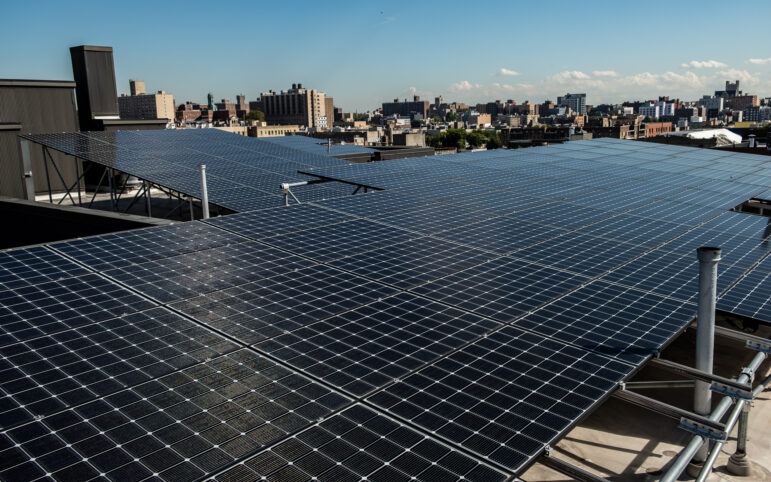Installing residential solar panels requires a hefty upfront investment. In 2023, it cost on average over $36,000 per property before incentives, according to the New York State Energy Research and Development Authority (NYSERDA).

Adi Talwar
Solar power panels at the Sherman Terrace co-op in the South Bronx. The panels were installed in 2020.Environmental advocates are pushing state lawmakers to pass a bill that would make the installation of solar panels more affordable for low-income homeowners.
Installing residential solar panels requires a hefty upfront investment. In 2023, it cost on average over $36,000 per property before incentives, according to the New York State Energy Research and Development Authority (NYSERDA).
The bill would help offset some of those costs by updating a 2006 tax credit that currently allows homeowners who go solar to reduce their tax payments by up to $5,000 or 25 percent of the cost of their system, whichever comes first.
The idea is to double that cap to $10,000 and give low- to moderate-income residents the option to collect the credit as a tax refund. Any remaining credit that exceeds the amount due in taxes would be returned to the homeowner through a check in the mail.
“By making it refundable, that means everyone can access it,” said Stephen Levin, CEO of Solar One, a non-profit dedicated to making sustainability more accessible.
The issue, Levin explains, is that homeowners who don’t make enough taxable income—like someone who is retired—end up not using much of the tax credit. By offering them the refund, “it addresses the equity issue” and opens the door for low-income residents to reap the benefits as well.
For one of the bill’s sponsors, Assemblymember Latrice Walker, the lack of access to incentives is a major barrier to getting more solar panels up and running across New York.
“It is no secret that New Yorkers are struggling to keep up with the rising costs of everything from utilities and rent to milk and eggs,” Walker said in an emailed statement. “The issue of clean energy is no exception. Solar energy is more affordable than ever and it should be accessible to all New Yorkers.
The legislation would also allow the tax credit to offset the costs of installing battery storage systems, an essential part of solar power. These batteries store the solar energy captured on site and release it when needed most, like when there is a blackout.
“When this tax credit was created, battery storage really wasn’t a thing. So being able to incorporate battery storage in there and have a tax credit that scales appropriately with the costs associated with storage, is really important,” said T.R Ludwig, founder and CEO of the company Brooklyn SolarWorks, who has been fighting for the bill to be introduced since 2019.
Ludwig says the bill will also be good for business, as solar panel installations are likely to increase.
Switching to solar can be arduous for homeowners to take on. In addition to doing the actual installations, Brooklyn SolarWorks says they go door to door educating New Yorkers about the benefits of making the change, and to guide them on how to apply for tax incentives.
“It will help create jobs. If my company is installing more solar panels I am going to have to go out and hire more canvassers or salespeople, more installers. And so stimulating the clean energy economy through this tax credit, that just makes a ton of sense,” Ludwig said.
As of last year, New York had 5,560 megawatts of installed solar, enough to power over 980,000 homes and provide 5 percent of the state’s electricity, according to the nonprofit Solar Energy Industries Association.
In total, there were over 200,000 residential-scale solar power systems installed in New York State as of last year, according to NYSERDA.
Emily Ng, director of member services at the tenant advocacy group Urban Homesteading Assistance Board (UHAB), believes making solar more accessible can increase the use of green energy in the communities that need it most.
“The goal should be to expand opportunities for clean energy technologies in communities that have faced environmental racism and are struggling to make the kinds of upgrades that are needed because these are the same communities that experience the impacts of climate change first and worst,” Ng said.
To reach the reporter behind this story, contact Mariana@citylimits.flywheelstaging.com. To reach the editor, contact Jeanmarie@citylimits.flywheelstaging.com
Want to republish this story? Find City Limits’ reprint policy here.








